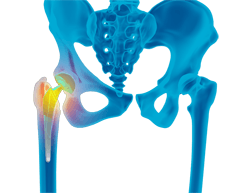
Revision Hip Replacement Surgeon in Raleigh, Garner, Cary, NC.
Occasionally, artificial components implanted during total hip replacement can wear out for various reasons and may need to be replaced using a surgical procedure known as revision hip replacement. The procedure involves replacing all or part of the previous implant with a new artificial hip joint. Dr. McNabb provides diagnosis and revision hip replacement surgery in Raleigh, Garner, Cary, NC. Dr. McNabb also provides highly specialized care during and after the surgery. Contact Dr. McNabb’s team for an appointment today!

What is Revision Hip Replacement?
During total hip replacement, the damaged cartilage and bone are removed from the hip joint and replaced with artificial components. At times, hip replacement implants can wear out for various reasons and may need to be replaced with the help of a surgical procedure known as revision hip replacement surgery.
Revision hip replacement is a complex surgical procedure in which all or part of a previously implanted hip joint is replaced with a new artificial hip joint.
Indications for Revision Hip Replacement
Revision hip replacement is advised for the following conditions:
- Worn out plastic liner
- Dislocation of previous implants
- Loosening of the femoral or acetabular component of the artificial hip joint
- Infection around the hip prosthesis
- Weakening of bone around the hip replacement (osteolysis)
Procedure of Revision Hip Replacement
During the procedure, an incision is made over the hip to expose the joint. Then, the femur is dislocated from the acetabulum so that the old plastic liner and metal socket if necessary can be removed from the acetabulum.
After removal, the acetabulum is prepared and a new socket is inserted. A liner made of plastic is placed inside the metal socket.
If the femoral component is required to be removed this will be done by disengaging it from the femur. A new femoral component will be placed. Then the femoral head component made typically made of ceramic is placed on the femoral stem. All the new components that are placed form the new hip joint. The muscles and tendons around the new joint are repaired and the incision is closed.
Post-procedure Care for Revision Hip Replacement
After undergoing revision hip replacement, you must take special care to prevent the new joint from dislocating and to ensure proper healing. Some of the common precautions to be taken include:
- Avoid the combined movement of bending your hip past 90 degrees
- Keep a pillow between your legs while sleeping for 6 weeks
- Do not cross your legs
- Avoid sitting on a low chair to avoid excessive flexion of your hip
- Avoid getting the foot of your operated leg too far behind you
- Based on bone quality you may also be asked to limit your weight on your revised hip
Risks of Revision Hip Replacement
As with any major surgical procedure, there are certain potential risks and complications involved with revision hip replacement surgery. The possible complications after revision hip replacement include:
- Infection
- Dislocation
- Fracture of the femur or pelvis
- Injury to nerves or blood vessels
- Formation of blood clots in the leg veins or the lungs
- Leg length inequality
- Wearing of the hip prosthesis
- Failure to relieve pain
If you would like to have additional information on treatments of hip conditions or would like to learn more about revision hip replacement, please contact Dr. McNabb, serving the communities of Raleigh, Garner, Cary, NC.






